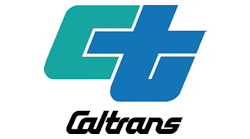Caltrans signs $80 million contract with Stadler to deliver first zero-emission, hydrogen intercity passenger trains in North America
On Oct. 12, the California Department of Transportation (Caltrans) signed an $80 million contract with Stadler Rail, Inc. to deliver the first zero-emission, hydrogen intercity passenger trains in North America.
The vehicles will be based on Stadler’s successful Fast Light Intercity and Regional Train concept, extending work done with the San Bernardino County Transportation Authority (SBCTA) to develop self-powered multiple-unit trains using zero-emission hydrogen fuel cells without the need of a separate locomotive. The purchase is funded through California Gov. Gavin Newsom’s $10 billion, multiyear zero-emission vehicle package, which included $407 million for the California State Transportation Agency to demonstrate and purchase or lease state-of-the-art clean bus and rail equipment and infrastructure.
SBCTA and Stadler unveiled the first hydrogen-powered FLIRT H2 passenger train at American Public Transportation Association EXPO 2023. The train has undergone extensive testing in both Switzerland and the U.S.
“California is once again leading the country in delivering innovative clean transportation options that benefit people and the planet. These state-of-the-art hydrogen train sets will demonstrate the capability of an emerging technology and will complement our future electrified high-speed rail line for an expanded clean rail network,” said Toks Omishakin, Caltrans secretary.
“California is using our transportation dollars to fund innovation solutions like these zero-emission, hydrogen passenger trains to significantly reduce planet-warming pollution and combat and adapt to climate change ― while providing travelers an alternative to driving,” said Tony Tavares, Caltrans director.
The contract includes a base order of $80 million for the first four trainsets, with options for up to 25 additional trainsets that can be used throughout California. While the base order of trains is expected to primarily operate between Merced and Sacramento on the expanded San Joaquin and Altamont Corridor Express Valley Rail services that will also connect with the early high-speed rail service between Merced and Bakersfield, the trains will also be demonstrated on corridors throughout California in coordination with intercity and regional rail partners.
The funding builds on more than $1 billion in zero-emission transportation investments in the past few months alone by the state of California. In July, Gov. Newsom announced approximately $450 million for zero-emission infrastructure, locomotives, vessels and vehicles as part of a historic investment to build a more efficient, sustainable and resilient supply chain. In April, Newsom announced more than $690 million for public transportation projects that will result in the purchase of 277 new zero-emission vehicles statewide and the development of several high-priority mobility hubs and rail projects.
“It is great to be part of California’s move toward eco-friendly travel with another zero-emission project in the state and we look forward to continuing our work with the California State Transportation Agency and Caltrans to make this a reality,” said Martin Ritter, CEO Stadler.

Brandon Lewis | Associate Editor
Brandon Lewis is a recent graduate of Kent State University with a bachelor’s degree in journalism. Lewis is a former freelance editorial assistant at Vehicle Service Pros in Endeavor Business Media’s Vehicle Repair Group. Lewis brings his knowledge of web managing, copyediting and SEO practices to Mass Transit Magazine as an associate editor. He is also a co-host of the Infrastructure Technology Podcast.





